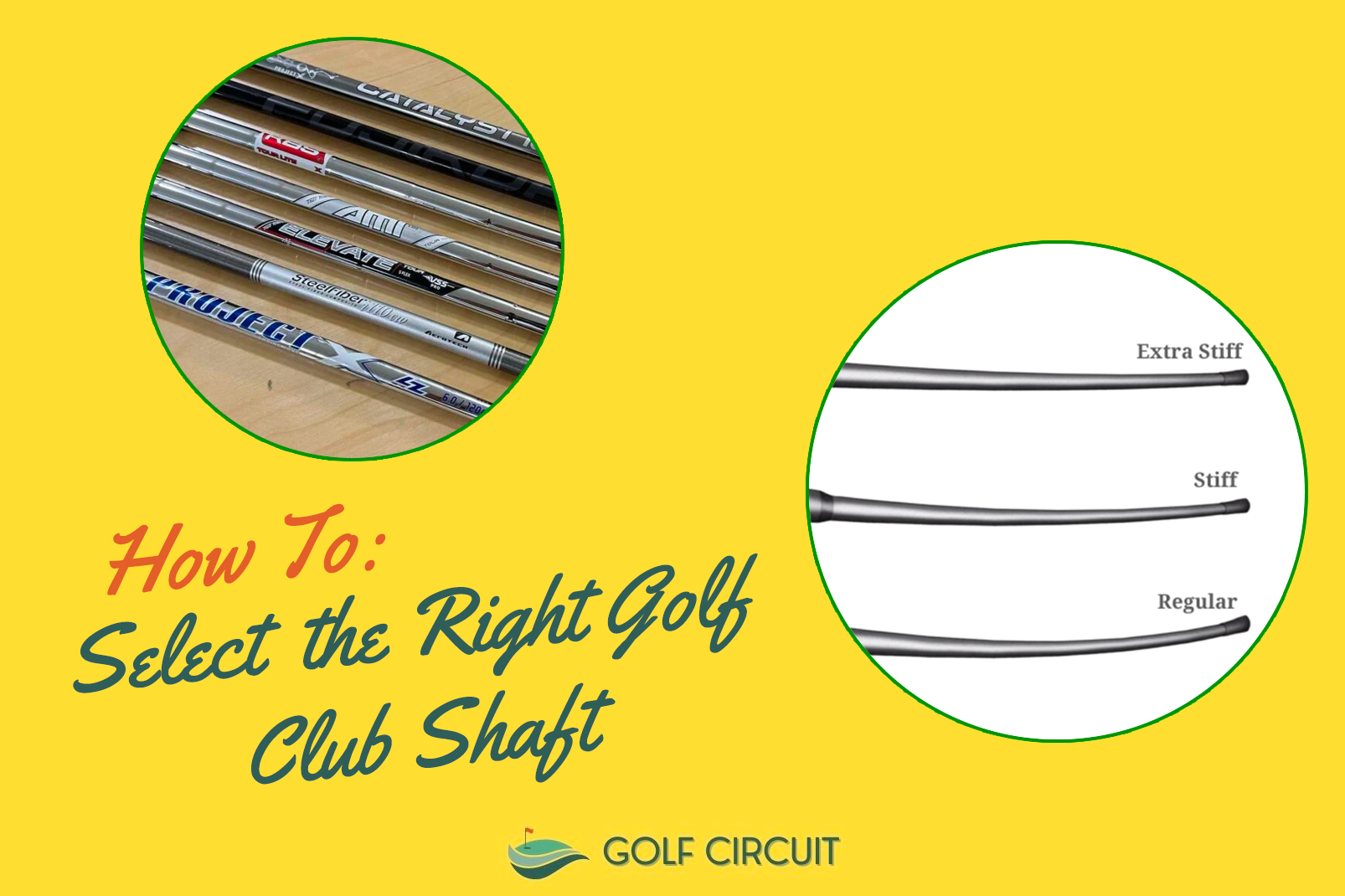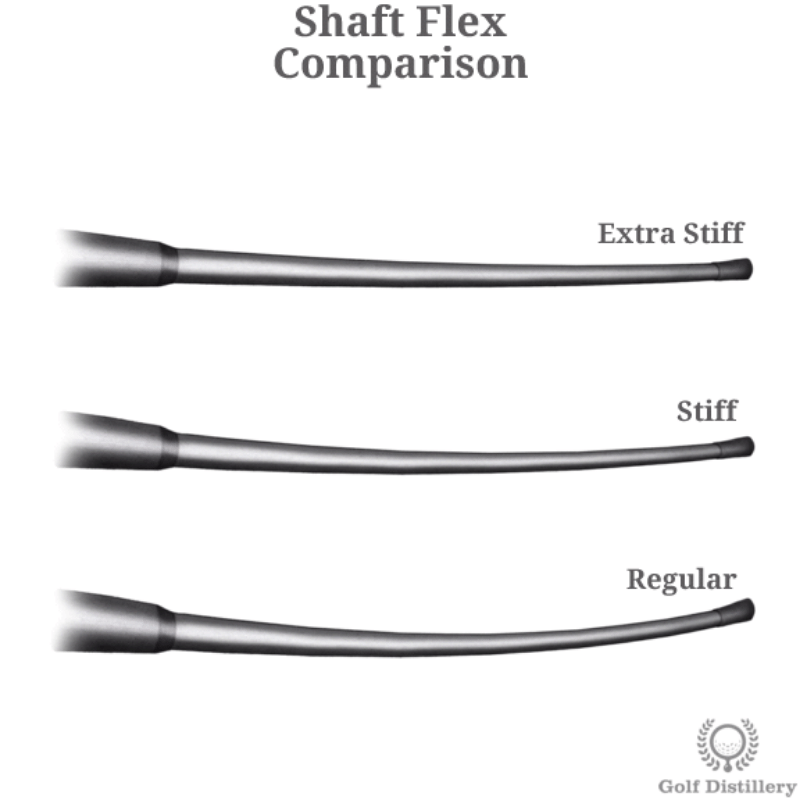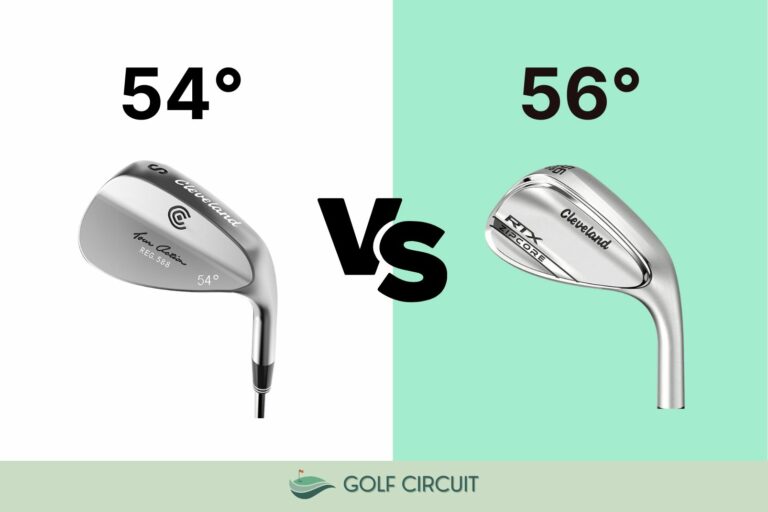How To Select Golf Club Shaft Flex?

It’s easy to blame a poor golf game on your equipment when in reality it comes down to skill a lot of the time. However, swinging clubs with the wrong shaft flex for your swing style can have a significant impact on how well you shoot. Squaring the clubface to the ball is important for a clean straight shot and getting the correct shaft flex is important in helping you do that.
You don’t want to have the wrong golf shaft flex dragging down your shots and your score. Here’s how you can select the most suitable shaft flex for your golf game to help control shot direction, ball flight, and distance.
Understanding Golf Club Shaft Flex

The golf club’s shaft is the part between the grip and clubhead. The flex determines how much the shaft bends during your swing and at impact.
This, in turn, affects the direction and distance of your shots. Matching your golf shaft flex with your swing is vital for distance and accuracy.
Tour pros and low handicappers tend to go with stiffer shafts that offer less flexibility. It helps the stronger players with faster swing speeds keep their clubhead in the most favorable position at impact.
Whereas those with slower swing speeds (like beginners, high-handicappers, women, and seniors) benefit from a higher (extra) shaft flex. Most starter golf club sets come with a more flexible shaft.
Impact of Shaft Flex On Your Game
The right flex helps control trajectory, improve accuracy, and maximize distance.
If you pick the wrong shaft flex, you’ll see that it impacts your game. When you swing the club, the ball won’t go as far as it should; also, you may hit the ball off-center causing a slice or a hook.
If you have a fast swing speed and use a high flex shaft the clubhead will lag and not be where it should be at the point of impact.
The clubface ends up with excessive loft, leading to too high a trajectory, tapering off distance, and reducing the amount of roll of the shot.
On the other hand, if slower swing speed golfers use a stiff shaft, it’ll result in an abrupt clubface angle at impact, causing the golf ball to be hit slightly early. This leads to a low trajectory, poor spin rate, and less carry distance.
Different Golf Shaft Materials
There are several shaft materials that you can select from when getting a new shaft for your club. Different materials have a significant impact on the amount of flex provided.
Also, keep in mind shaft materials do vary from your driver and woods to your irons and wedges. While professionals typically use steel irons and wedges, their drivers and woods are almost always graphite.
Since multi-material and titanium shafts are a bit less common, the question usually comes down to steel vs. graphite shafts.
Steel
These shafts are stronger and the most durable of the lot. They’re also heavier and not as expensive as graphite ones.
A standard on most entry-level golf clubs, there are two variations – rifle steel and stepped steel. While the rifle is a smooth shaft, stepped has steps or ridges along the shaft.
Steel shafts are naturally stiff and therefore are usually only offered in regular, stiff, or extra stiff flex’s.
Graphite
The more popular graphite shafts are lightweight, more expensive, and not as durable as the steel ones but offer higher flex than steel.
Multi-Material
These are combinational shafts that use graphite and steel. While it’s more expensive than steel shafts, it doesn’t cost as much as graphite.
Multi-material shafts are common in both drivers and irons and typically have steel shafts with a graphite tip to limit the whip.
Titanium
A relatively new shaft material, titanium makes a lighter shaft yet, is as strong as steel. It’s also the most expensive shaft material.
Different Club Shaft Flex Levels
There are five different levels of shaft flex. The right one for you is mainly determined by your swing speed.

Extra Stiff (X)
This is what most high-level players (like professional and scratch golfers) opt for. The longest of hitters use the extra stiff shaft owing to the swing speed they generate.
However, they’re less common for your average weekend golfer and not very sought after. A word of caution – having too stiff a shaft could diminish your loft and control over shots.
If you swing the driver above 105-110 mph, carrying it beyond 275 yards off the tee, the extra stiff shaft is a perfect choice.
Stiff (S)
A common one with low-to-mid handicappers, who, most likely, won’t be out on Tour anytime soon, the stiff flex is for the higher-than-average swing speeds and carry distances.
Stiff shafts are ideal for you if your swing speed ranges between 95-110 mph and you’re driving your golf ball between 240-275 yards consistently off the tee.
Regular (R)
The regular flex shaft is the most common one used by most golfers, especially new male golfers. This shaft won’t bend as much, yet, gives you a slight flex for achieving optimum momentum.
The regular shaft is the correct shaft flex for normal range of golfers with swing speeds between 85-95 mph, whose drives cover a distance between 200-240 yards.
This is one forgiving flex that male high handicappers can consider for ensuring they attain a good range.
Amateur or Senior (A)
The slow swingers, like senior or older players, or even amateurs or entry-level players, can use the senior flex shafts.
As people get older, they start losing swing speed, distance, and their swings get shorter. At this stage, a senior flex shaft will help maintain accuracy and distance.
Anybody with a slow swing speed between 75-85 mph and a driver carry distance of 180-200 yards should consider using this flex shaft.
Ladies (L)
Ladies flex is among the softest type of shaft, is highly flexible, and is extremely forgiving. While it’s primarily designed for the female market, by no means do all women golfers fall in this category. Younger, low handicap women with strong swings will often opt for steel shafts.
This is the correct shaft flex for anyone whose swing speed falls under 75 mph and whose driver carry distance falls under 180 yards.
The Golf Shaft Flex Chart
Here’s a golf shaft stiffness chart that shows the right flex for different golf swing speeds and carry distances.
| Swing Speed | Carry Distance | Shaft Flex |
| < 75 mph | 180 yards | Ladies (L) |
| < 85 mph | 200 yards | Senior (A) |
| 85-95 mph | 200-240 yards | Regular (R) |
| 95-110 mph | 240-275 yards | Stiff (S) |
| > 110 mph | > 275 yards | Extra Stiff (X) |
Signs You’re Playing the Wrong Flex
Look out for these signs that you’re playing with the wrong flex.
For a shaft flex that’s too stiff:
- You can’t hit the golf ball as long or high as with your other clubs.
- The ball tends to slice or fade (goes to the right for a right-hander and the left for a left-hander).
- Even when you make centered contact with the clubface, your shots don’t feel solid at impact.
For a shaft flex that’s too soft or flexible:
- The ball will have a high launch trajectory, resulting in lost distance.
- The ball tends toward a hook or leans more to the draw side (goes to the left for a right-hander and the right for a left-hander).
- Even a solid hit doesn’t get the distance it should.
Selecting the Right Shaft Flex
While it’s best to go to a club fitter to help determine the appropriate flex based on your swing, here are some basic specifications used in the process.
Based on Swing Speed
Determining the right shaft flex is done based on swing speed and seeing which shaft flex is right for your club head speed.
How To Determine Swing Speed
Since swing speed helps determine the correct shaft flex, you’ll need to determine this first. Here are the ways to go about this:
- A launch monitor: It measures the swing speed for every shot you hit.
- A golf retailer: Most golf stores have golf simulators, allowing you to test various irons and drivers and tell swing speeds. It isn’t necessary to buy anything, but you’ll know which is the correct shaft flex for your swing.
- A demo day: Golf manufacturers like Callaway, Titleist, and TaylorMade commonly host demo days on driving ranges. They bring their different clubs, and you can hit shots while a club representative monitors your stats.
Shaft Length
An equally important factor is the shaft’s length. We’ll cover this topic briefly but also have an in-depth shaft length guide.
The wrong-length shaft causing a 0.5-inch off-center strike can result in a 7% carry distance loss, and an off-center strike by one-inch results in a 14% carry distance loss.
To select the appropriate shaft length, stand straight and have someone measure the length from where your hand meets your wrist (crease) down to the ground. Take the average measurement of the length for both hands.
Here’s a table to help you determine the right golf club shaft length you’ll need:
| Length (from the crease to floor) | Golf club shaft length |
| 29”-32” | 37” |
| 33”-34” | 37.5” |
| 35”-36” | 38” |
| 37”-38” | 38.5” |
| 39”-40” | 39” |
| > 41” | 39.5” |
Shaft Material
The two common options are steel and graphite shafts. If you’ve got a below-average swing speed, go with the lightweight graphite shafts that are easier to swing/hit and more forgiving.
A graphite shaft will help add distance to your swing, with a compromise on accuracy. It’s better suited for beginners, seniors, and lady golfers who struggle to generate distance with steel shafts.
With the heavier (and more durable) steel shaft that doesn’t twist, the focus is more on accuracy than distance, and golf shots are easier to control. Usually, the more advanced or experienced players prefer steel shafts.
However, you’ll require a faster swing speed (about 90-110 mph) to compensate for the distance loss with steel shafts.
It’s common to find steel shafts in wedges and irons, and graphite shafts in woods, drivers, and hybrids.
Kick Point
The flex point of the shaft is its kick point – it’s the point your shaft bends during your swing and affects your shot’s trajectory.
Golf shafts come with low, mid, or high kick points. A high kick point results in a lower trajectory, with a more stiff and solid feel.
Whereas a low kick point gives a high trajectory, with the feeling of the shaft tip whipping the clubhead.
Go with a low one if you struggle to get your ball up and a high kick point if your shots float and cause you to lose distance.
Shaft Torque
Torque determines how much the shaft twists (in degrees) during the swing movement.
A higher torque rating means more shaft twist (and a softer feel) during your swing, producing higher shots and more distance.
Lower torque results in a more accurate, lower ball flight.
For example, a 5-degree torque will feel softer than a 3-degree torque.
Weight
Shaft weight helps generate club head speed and increase your swing distance. The typical shaft weights range between 50-85 grams.
Lightweight shafts tend to be swung faster, increasing club speed, resulting in more distance and speed but reduced accuracy. As you already know, graphite shafts are lighter than steel.
A driver with a light shaft will help add distance, while a 3-wood with a heavier one will help hit more fairways. Finding the right weight shaft is vital to maintain control and increasing club speed.
Final Thoughts
While finding the perfect golf shaft flex for your playing style can be difficult, you can always consult a professional.
Custom-fit clubs can get expensive, but you’ll have perfect shafts to suit your swing metrics. With a launch monitor, the club fitter watches your golf swing and tracks the ball speed, club head speed, spin rate, and smash factor.
Do you need a softer flex or the extra stiff shafts? There’s no room for guesswork when it’s done the right way.






